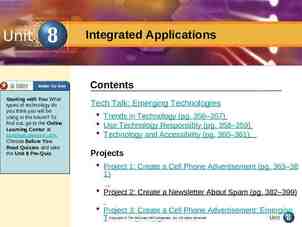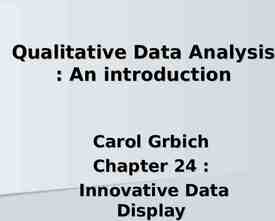8-Point Plan for the First 100 Days
10 Slides1.15 MB
8-Point Plan for the First 100 Days
Rough Timeline for the 8-Point Plan Several of the steps occur simultaneously and many take place continuously Following our 8-point plan, we will help you create the conditions for great long-term performance. PROPRIETARY AND CONFIDENTIAL. ALL RIGHTS RESERVED 2
Point 1: Prepare Yourself During the Countdown Action Items Comments Plan effectively; get set to learn. Do your homework; review company, industry and competitor press, financials and marketing materials. Determine what questions to ask key constituents and meet with the smartest observers possible. The best questions yield the best answers. Meet with top management, your boss, employees, alumni, customers, suppliers, analysts, trusted confidantes and investors. Lay the groundwork for strong relationships with your key constituents and future colleagues and gather valuable input. Construct your first 100-day plan with tasks and rough timing. Once you start your new job, the rush of information and activities will make it difficult to think and plan. Assess your own knowledge, skill or experience gaps. Determine what functional expertise or specialized training you will need to succeed in the new job. Prepare family and your personal support base for the intense ride ahead. Minimize personal disruptions within your control; create the ability to immerse yourself in your new role in the first 100 days. PROPRIETARY AND CONFIDENTIAL. ALL RIGHTS RESERVED 3
Point 2: Align Expectations Action Items Comments Truly understand your boss and the company’s objectives for the position you are coming into. Make sure you find common ground about key goals — both during the hiring process and throughout your early days. Introduce yourself to the management team: Most employees will be wondering, “Is this new boss going to be good or bad for me?” Prepare to answer these questions: Who am I? What’s my background? Why did I join? What do I hope to accomplish? How do I hope to work together? Be CONCISE. Communicate your management philosophy, professional background, operating principles and expectations. Use your early management meetings to do more than meet and greet; set the tone for weeks to follow. Ask a lot of questions. Don’t be a know-it-all. You cannot have all the answers on day one or throughout the first 100 days. Create an agenda for active listening; engage in one-on-one meetings to pose key questions. Be a receiver as much as a broadcaster — listen and learn. People appreciate being listened to and heard. Do not go into “broadcast mode.” Synthesize learnings and provide feedback to the organization and those with whom you’ve met. Begin developing your agenda by sharing what you have learned through memos, presentations and social media. PROPRIETARY AND CONFIDENTIAL. ALL RIGHTS RESERVED 4
Point 3: Shape Your Management Team Action Items Comments Determine whether you have a strong enough management team to reach your aspirations. Establishing a strong team is the best first step a manager can take toward implementing and executing the strategic agenda. Build a team of people with similar values and passions, but with complementary skills. The composition of the team should match the company’s challenges, enable you to do your best, and reflect the values and standards that you want to prevail throughout the enterprise. Unless the company is in utter crisis, avoid making critical personnel moves immediately. Recognize that people have enormous capacity if you give them a chance; set clear expectations and hold them accountable. Cultivate a partner or confidante. You will need someone trustworthy, discreet and with superior judgment with whom to brainstorm. Articulate objectives and desired outcomes; encourage frank and open conversations. Your early team meetings will set the tone for the meetings to follow. Recognize the power of your predecessor; While it may be tempting to push out or acknowledge and, in some cases, embrace denounce your predecessor for the your predecessor. challenges you’ve inherited, doing so will PROPRIETARY AND CONFIDENTIAL. ALL RIGHTS RESERVED likely create unnecessary ill will. 5
Point 4: Craft Your Strategic Agenda Action Items Comments Build the strategic agenda in a joint effort with your team versus in a silo. Limit the number of themes and priorities so they can be easily remembered by the organization. Find the right balance between creating a compelling picture of where you want the organization to go and not becoming prematurely locked into a plan. Diagnose the company’s problems starting with the customer perspective and continuing with a grounded view of what the company stands for. Use this diagnosis and your constituents’ feedback to start building your short-term strategic agenda; make sure to underpromise and over-deliver. Define the operating mechanism/process — the meetings, documents and report formats to conduct the day-to-day business. Incorporate these processes and build an explicit plan to address cultural issues and barriers to change. A strategic agenda is by definition a work in progress; use it to help you and the organization make decisions, see how they work and make adjustments as needed. Expect pushback on your agenda but, rather than resist, coalesce that input in a positive way to maximize buy-in. Secure some early wins. Look for flaws in the organization and fix them quickly to establish your credibility as a leader. PROPRIETARY AND CONFIDENTIAL. ALL RIGHTS RESERVED 6
Point 5: Start Transforming Culture Action Items Comments Identify how “things work around here.” Work to understand the culture of the new organization and diagnose how great of a change is required. Many new leaders fail because they could not make headway against an intransigent culture, pushing too hard in the wrong ways. Go on the hunt for the knowledge networks, key influencers, decision-making protocols and the unwritten and unspoken conventions that are the nervous system of any organization. The place to start assessing a culture is to look for physical evidence, then listen and learn — within most appearances and generalizations there lies an inner core of truth. Solicit views about the culture from members of the board, the management team, employees, customers and industry analysts. As you learn more, keep sharpening and improving your questions. Create the conditions for cultural transformation: adapt measures of success; set new expectations; create new operating processes; empower change leaders; and lead by example. Be sensitive to the fact that even when you have a change mandate from your board or boss, it may not be enough. Understand where other sources of power lie. With a truly obstinate culture, you may Make your first moves count. In your early need to make structural and people days, people are the most open about changes, but do so with the bought-in change, but remember that too much PROPRIETARY AND CONFIDENTIAL. ALL RIGHTS RESERVED support of the key power center and change can break the culture — so pace establish a concerted program to address yourself, continually assess the tolerance of 7
Point 6: Manage Your Boss Action Items Comments Understand the stated and unstated motivations of your boss. It’s not just about building shareholder value, it’s also about their reputations and schedules. Initiate an “onboarding” process with your boss, similar to what can be done with new managers. Establish priorities with your new boss. Sit down with your boss and determine the most critical issues and what he/she is and the board are looking for. Establish your credibility by having a sound strategic agenda, being on top of the details of the business and by establishing an effective communications protocol. Understand how your boss really works. Tailor your communications and management style accordingly. Listen and learn from your boss. Establish the discipline of regular feedback. PROPRIETARY AND CONFIDENTIAL. ALL RIGHTS RESERVED 8
Point 7: Communicate! Action Items Comments Know your audience so you can tailor your message and your style to their readiness and to what they care about. Tell stories to establish an emotional connection to your point; be concise. Effective communication is more than promulgating a message, it is a continuous give-and-take in which ideas are explored, assimilated and adapted. Be conscious of the signals you are sending. In the early days, every move you make is being closely watched — both explicit messages and implicit signals will have an impact. Use and re-use your communications in various forums and formats. This will reinforce your message and maximize your time. Know the communications settings that you are most comfortable in and play to your natural strengths. Communicating is intimately intertwined with corporate culture; the way you present your message will affect the culture. In a crisis, get the information out as quickly as possible. Acknowledge the challenges of the situation to establish credibility; act as a “shock-absorber” between uncertainty and employees’ desire for stability. Having all the answers is usually the wrong answer; get direct input from the field. While this requires significant time investment, it will pay back multiple-fold in enhanced credibility, trust and stakeholder engagement. PROPRIETARY AND CONFIDENTIAL. ALL RIGHTS RESERVED 9
Point 8: Avoid Common Pitfalls Action Items Comments Don’t set unrealistic or unsustainable expectations; in the end, you will be judged by your results. Serious problems arise when the targets against which you are measured are not rooted in reality. Don’t allow yourself to suffer from analysis paralysis; don’t be a know-it-all and make rash decisions. Overly cautious behavior eats up time and sets the example of risk aversion; know-italls typically don’t know what they don’t know. Don’t fail to let go of your past identity. Don’t stifle dissent. What’s past is prologue. Leaders who smother discord cut themselves off from correcting problems before they arise and create an environment of fear. Don’t misread the true sources of power and don’t pick the wrong battles. Gauging the true sources of power is critical during the early days. Select the right priorities; little things may turn out to be not so little after all. Don’t succumb to “the savior syndrome” and avoid “dissing” your predecessor. You are not the embodiment of the institution. You are not above the rules that bind everyone else. Be respectful and sensitive regarding your predecessor’s position and tenure, regardless of how you feel. PROPRIETARY AND CONFIDENTIAL. ALL RIGHTS RESERVED 10















